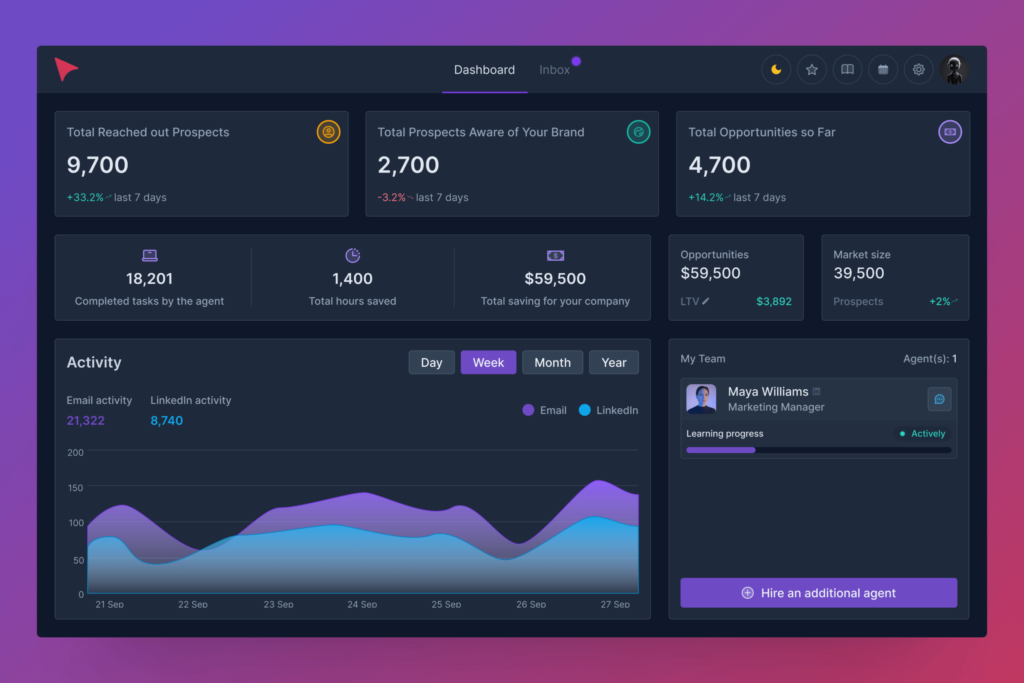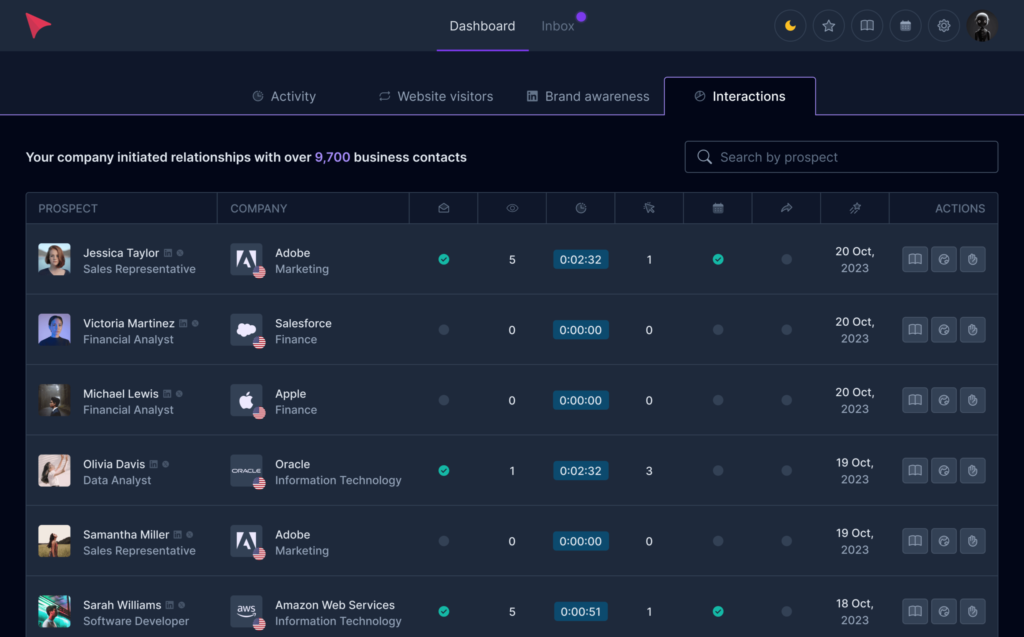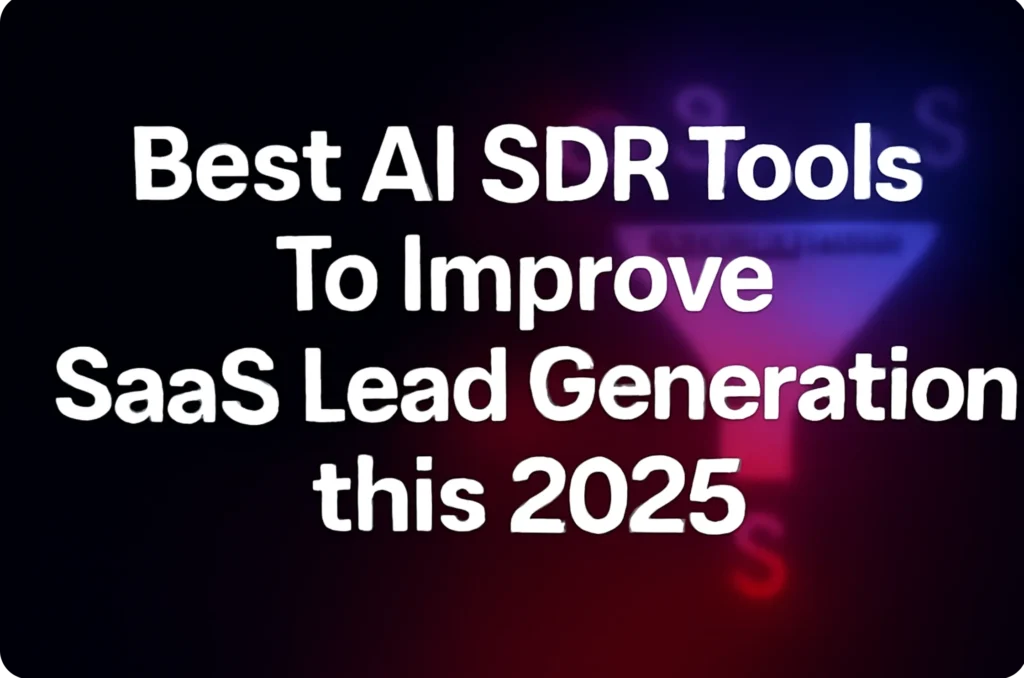Insurance is a necessity for everyone.
Whether it is for health, car, or home, having insurance provides everyone with the sense of security that if some unforeseen circumstances occur, there is a guarantee that you have financial coverage.
But does this mean that sales and marketing is not necessary?
Despite its reputation of being a necessity for many people, some people consider insurance as just an additional liability, rather than an asset. Furthermore, countless potential customers remain unaware of the coverage they can obtain by subscribing to your insurance policies.
Recent statistics confirmed that almost 50% of Americans do not have life insurance, while there are 9% who are unaware if they signed up for one.
Integrating a lead generation strategy can be considered as an insurance policy for every business.
But would this be enough?
Reaching the right audience, while capturing their interest sounds incredibly challenging, but implementing the right strategy and tools can make all of the difference.
For this blog, we will unveil how lead generation for the insurance industry works, including the proper strategy you can implement and we will uncover how Anybiz can be the best and most effective technology you integrate to develop your lead generation process.
What is Lead Generation for Insurance?
Lead generation, in a nutshell, is the practice of generating potential customers (leads) that are most likely to have shown interest in your product or service. It involves procedures that will attract and convert potential customers and nurture them into actual paying clients.
Lead generation for insurance is not that different from other processes, it operates under several channels and strategies:
Drawing In Leads
It begins with drawing in leads via compelling marketing materials —education or focused advertising.
Establish Personal Connection
Sales leaders should then provide extreme attention for prospects that expressed interest for an insurance policy, building personal communication, addressing concerns, establishing resolution and presenting detailed information of what they exactly need.
Assistance in Making Finalized Decision
The endgame is to assist the ideal prospect of finalizing a decision — hopefully closing a sale.
Lead Generation Strategies for the Insurance Sector
1. Commercial Insurance Lead Generation
Commercial insurance targets business clients requiring insurance policies that need to secure company assets, employees, and operation. Lead generation techniques involved in this process are:
Networking
Targeted Digital Advertising
2. Home Insurance Lead Generation
Home insurance is a necessity for every homeowner, this would mean that they will require an insurance that secures the property and safeguard their investments. Lead generation that can work for this type of necessities are:
- Mailed Catalogue of Enthusiastic Customer Reviews
- Targeted and Featured Blogs for topics that frequently trouble homeowners on SERP, radio and local newspaper ads.
3. Life Insurance Lead Generation
Life insurance are those who are seeking financial security of their families and dependents. Most people that are looking for this insurance are considered providers and breadwinners, strategies that will be effective for this are:
- Live Seminar — mainly discussing about the importance and purpose of purchasing life insurance
- Social Media Advertisements — how to secure the financial future of their partners and/or child.
- Email Newsletters — providing them with a list of benefits and policies they can avail.
Types of Leads in Insurance
The ways in which leads are created, shared, and used can differ greatly in the insurance sector.
Real-Time Leads
These are created leads that are sent right away after acquisition to insurance companies. Being quick guarantees that the data is up to date and that you can get in touch with the prospect when their interest is at its highest. Because of its great conversion potential and freshness, this kind of lead is highly desired.
Live Transfer Leads
Prospects who have shown interest are considered live transfer leads, and they are then given straight phone access to sales staff. Since the lead is engaged and prepared to talk about their insurance needs in real time, this instantaneous handoff boosts the likelihood of conversion.
Search Leads
These leads are generated by search engine marketing (SEM) and search engine optimization (SEO) from prospective clients who are actively looking for insurance products on the internet. Because the prospects in this type of lead have previously demonstrated a high degree of intent and interest in buying insurance, it is especially important.
Exclusive Leads
Exclusive leads are not shared with any competitors and are sold to a single insurer. Because of this exclusivity, there is no competition from other providers, increasing the lead’s likelihood of conversion. Although exclusive leads are usually more costly, they have greater potential for profit.
Shared Leads
Shared leads, as opposed to exclusive leads, are shared by multiple insurers. Due to several organizations contacting the same prospect, this lowers the cost per lead but also increases competition. In order to differentiate oneself from other insurers pursuing the same client, shared leads necessitate a robust follow-up plan.
Main Challenges in Insurance Lead Generation
Part of crafting an effective sales and marketing strategy is recognizing the challenges tied to lead generation. Some are obvious, while others lurk beneath the surface — striking when you least expect them
1. Intense Competition
Capturing the attention of potential customers in a competitive environment, such as the insurance industry can be difficult. Standing out, constant improvement of insurance plans, and emotional connection would be your qualifier and potential game changer.
2. Problems with Lead Quality
It can be a matter of quality vs quantity. Producing a large number of low quality leads may be detrimental to your success. Leads with low quality — those that have minimal potential to become customers can waste resources, time, and energy making your lead generation campaigns less productive.
3. Changing Customer Expectations
The insurance industry is perhaps one of the most highly regulated landscapes in the world. Following a strict set of legal guidelines and requirements, including ethical considerations in gathering, managing and utilizing personal data for lead generation may warrant concern if not accomplished properly.
4. Regulatory Constraints
Part of the constant changes in customer demand are staying updated with technology improvements. There is no denying that digital channels are at the center of lead generation, this enforces the need of insurance companies to implement new technologies, such as AI-driven analytics.
5. Digital Transformation Challenges
Insurance businesses need to stay up to date with technology improvements as digital channels take center stage in the lead generating landscape. Operationally and financially, integrating new technologies—from AI-driven analytics to automated marketing platforms—presents obstacles.
6. Tracking ROI
Having an ROI calculator can be a huge advantage since it can help you in understanding which techniques are the most productive and most effective, especially for the insurance sector that has lengthy sales cycles.
10 Proven Lead Generation Strategies for Insurance Using AI Tools

1. AI-Driven Predictive Analytics
The sales process mainly involves anticipation, location, and conversion. To ensure the effectiveness of these disciplines incorporating A-driven predictive analytics is necessary. This will include evaluation of large datasets, providing the ability to identify trends, and forecast future business from potential consumers.
How It Works
- Data Collection. Artificial intelligence algorithms gather and analyze extensive amounts of data from numerous sources, comprising online engagement, social media usage, and historical buying decisions.
- Pattern Recognition. The AI algorithms uncover data about customer preferences and actions by identifying trends and patterns in the data
- Lead Scoring. Score prospects that are most likely to convert
- Targeted Campaigns. Insurance companies can design marketing campaigns that will be most likely to resonate with demographic groups using predictive data.
2. Chatbots for Initial Engagement
Chatbots are AI-powered virtual assistants that improve a business response time, and develop engagement levels of users upon initial interaction. It warrants an immediate response that develops lead capture and optimizes the sales funnel.
How It Works
- Instant Interaction. It can be programmed on social media, mobile apps and websites ensuring availability for 24/7.
- Query Resolution. Some customers may just need an answer to frequently asked questions, including justifications of insurance plans, and assist consumers in their first research of insurance options.
- Lead Qualification. Chatbots can rapidly determine the requirements and qualifications of prospective leads by posing relevant questions. They can then route qualified leads to human agents for additional action.
3. AI-Enhanced Customer Profiling
With its ability to analyze enormous volumes of data, at a rapid rate, AI can implement an enhanced customer profiling which can develop precision targeting, enabling higher conversion rates, effective resource allocation, and better customer relationship management.
How It Works
- Data Integration. Providing a complete picture of each potential client, AI systems can combine data from multiple sources, such as online activity, transaction histories, social media activity, and demographic data.
- Pattern Analysis. AI uses machine learning to find patterns and trends in the data, allowing it to differentiate between various client preferences and behaviors.
- Customized Engagement. Insurance marketers can increase the relevance and efficacy of their campaigns by customizing their messaging, offers, and products to meet the distinctive characteristics of each group based on the profiles.
4. Automated Email Marketing Campaigns
Email remains as one of the most effective and centralized forms of marketing communication in existence. Therefore implementing automation in email marketing can decrease manual workload and can contribute to an increase in response rates.
How It Works
- Emails with triggers. Emails are sent out by AI systems in response to predefined actions or triggers found in consumer interactions.
- Effective Observations. Automation solutions help to sustain engagement and move leads down the sales funnel by scheduling follow-up emails depending on customer responses—or lack thereof.
- Campaign Analysis. AI systems continuously evaluate the effectiveness of email campaigns, from every engagement to hone tactics and enhance subsequent correspondence.
5. AI-Optimized Paid Advertising Campaigns
Incorporating AI for paid advertising helps maintain product relevance, improve user experience and scalable campaign management; this can help maximize their ROI and budget allocation.
How It Works
- Accurate Targeting. Utilize massive data analysis to pinpoint the most promising leads based on their online habits, tastes, and past interactions with insurance-related information.
- Budget Optimization. AI systems make the optimal use of resources by dynamically allocating funds among various channels and ad sets in response to real-time performance measurements.
- Performance Evaluation. Enhances the precision of its forecasts and the effectiveness of ad spending by continuous learning from running ads, which eventually results in increasingly successful advertisements.
6. Social Media Targeting
Social media is an effective platform in terms of advertising material, establishing brand awareness and improving your network. Integrating AI with social media helps a company achieve a higher level of engagement and enable the most promising campaign.
How It Works
- Audience Segmentation. AI creates highly targeted audience groups by segmenting individuals based on their interests, actions, and demographics from social media data.
- Content Customization. Ensuring that each audience segment receives messages that are relevant to their particular needs, algorithms are used to modify content to meet the tastes and behaviors of various audience segments.
- Ad Optimization. Regularly testing different social media ad components, such call-to-actions, photos, and headlines, to see which combinations result in the highest conversion rates and levels of engagement.
7. Content Personalization
Customizing content using AI developments can help improve user engagement. For the insurance industry this can develop highly relevant and personalized information for its prospects and help them acquire the insurance plan they will need.
How It Works
- Behavior Analysis. Comprehend user preferences, interests, and possible insurance needs.
- Adaptive Dynamic Content. AI tailors the content—from blog posts and articles to videos and interactive tools—displayed to each user based on the insights gathered.
- Automated Corrections. As AI gains more knowledge about each user, it continuously improves the content recommendations, making it more personalized.
8. SEO Strategies
Search Engine Optimization (SEO) can help you achieve higher rankings in websites — helping you attain more organic attention. Incorporating AI in SEO can boost keyword optimization, organize contents and optimize user experience.
How It Works
- Keyword Optimization. The best keywords and phrases for insurance-related topics are found by using AI techniques that examine search patterns and user behavior. These phrases are then easily included into content to increase organic visibility.
- Content Organization. Artificial Intelligence helps arrange content so that it is easier for visitors to read and for search engines to crawl, which helps to ensure that relevant content is efficiently indexed and ranked.
- Improved User Experience. In order to improve website components like navigation, load speeds, and mobile responsiveness—all of which are essential for SEO rankings.
9. Machine Learning for Lead Scoring
AI-powered lead scoring enhances effectiveness by enabling sales teams to focus on high-priority leads, which cause significant increase in conversion rates and optimize resource allocation.
How It Works
- Pattern Identification. Identifies the traits and actions that most suggest a lead has the potential to convert.
- Rating Scheme. Concentrate resources on the most potential leads, this scoring system assists in prioritizing outreach activities.
- Dynamic Modifications. The machine learning approach ensures that the scoring system adapts to shifting trends and behaviors by updating lead scores in real-time as new data is received.
10. Virtual Reality and Interactive Tools for Engagement
Virtual Reality (VR) and interactive tools enhance customer understanding by making insurance products more accessible and easier to grasp, and help them stand out from competitors by offering a modern, differentiated customer journey.
How It Works
- Immersion-Based Exhibitions. VR can mimic real-world situations where insurance products would be required. For example, it can be used to create virtual home tours that highlight the advantages of homeowners insurance.
- Interactive Instruments for Decision Making. Potential customers can enter their information and preferences into tools like interactive calculators or customizable policy explorers to see how various insurance plans might fit their needs.
- Instantaneous Communication. These technologies can come with real-time communication features letting users ask questions and have instant conversations with insurance agents while immersed in the experience.
How Can AnyBiz.io Help with Insurance Lead Generation

Anybiz represents the intelligence, creativity and resilience of human agents, with the efficiency, automation and innovation of artificial intelligence. This platform not only simplifies lead acquisition but also enhances the overall quality and conversion rates of these leads through advanced technology and strategic integration.
Advanced AI Capabilities of AnyBiz.io
- Immense Prospect Database
Anybiz’s AI sales agent leverages a database of over 400 million prospects, which are instrumental for marketing pursuits, such as outreach.
It utilizes its multi-channel engagement system via email, LinkedIn, and AI cold calls. Each can be used depending on the engagement triggers.
Here is a brief explanation about this feature.
For Email
Email will be the initial channel that will send personalized messages to prospects.
After that, an automated follow-up sequence will follow. These follow-ups can be adjusted based on your prospect’s engagement level. Our system also has this impressive capability to classify your prospect’s engagement level — whether they are interested, have a buying intent, or have a positive feedback — allowing the AI sales agent to develop a segmentation process.
For LinkedIn
Using Anybiz and its AI sales agent can help you utilize LinkedIn to develop your outreach activities. The AI sends a profile connection request to your prospects who engaged with your emails but may require further touchpoints and rapport building.
Once the connection is established it will reinforce communication and encourage further engagement via follow-up messages.
For AI Cold Calls
For highly engaged prospects, the AI sales agent can schedule phone calls as part of its outreach sequence, thus enabling a more personalized touch and allows for direct communication. It can also send reminders for both prospects and users before scheduled calls to ensure higher attendance.
For highly engaged prospects, AnyBiz.io can schedule AI phone calls as part of its outreach sequence, and can send reminders to both prospects and users before scheduled calls to guarantee higher attendance rates.
Pipeline View and AI Dashboard
Anybiz follows the principles of what makes an effective sales management and enablement system by developing our exclusive AI dashboard and pipeline view.
The Pipeline View offers an intuitive layout that can:
- Track opportunities based on their status
- Easily move deals through different stages
- Get a clear overview of your sales progress in a single view
Meanwhile, the AI dashboard provides you with the detailed overview of the AI sales agent’s progress, action and activity.
The LinkedIn engagement shows how the agent interacts on LinkedIn. The Call Activity can track call outcomes, whether your calls are getting ignored, or have been responded to. And social media performance can monitor engagement across social media channels such as Facebook, LinkedIn and Twitter.
This will give you the chance to see and review all of your potential deal, and enable your sales team to understand where you are at your sales process.
Establishing recognition, as well as trust, is a critical part of your sales system. It serves as a leeway for your target audience to take notice of your product or services.
Social media is a powerful tool for this pursuit, and by integrating the AI sales agent to your social media platforms such as LinkedIn, Facebook and X (formerly known as Twitter), it can generate various engagement opportunities such as:
- Post creation
- Content engagement (likes, shares, and comments)
Cost-Effectiveness and Performance Benefits

Anybiz’s ROI calculator is a free tool that can help you understand how much profit the AI sales agent can actually bring to your sales team.
The calculator can predict the number of opportunities and calculates the expected ROI.
It highlights cost savings, improved outreach efficiency, and compares AI SDRs with human SDRs. Here is how you can use it:
- Enter your website domain
- Add your expected Customer Lifetime Value (CLV)
- Choose your target country for outreach
- Get your ROI estimate instantly
The calculator then predicts the number of opportunities and calculates the expected ROI. It highlights cost savings, improved outreach efficiency, and compares AI SDRs with human SDRs.
Comprehensive Engagement Tools
- Multi-Channel Engagement. AnyBiz.io operates across various platforms, including Email, LinkedIn, and Twitter, ensuring that potential clients can be reached through their preferred channels, which increases the likelihood of engagement.
- Automated Meeting Scheduling and Email Responses. These features streamline communication and follow-up, ensuring that potential leads receive timely and relevant interactions, which helps maintain their interest and move them closer to a sale.
AnyBiz.io offers a robust, AI-enhanced solution that transforms traditional lead generation efforts into dynamic, results-oriented campaigns. By implementing AnyBiz.io, insurance companies can expect not only to increase their lead generation efficiency but also to enhance lead quality and conversion rates, ultimately leading to substantial growth and a strong competitive edge in the market.
Anybiz as the Ultimate Investment and Insurance
AnyBiz.io offers a distinguishable advantage compared to its traditional lead generation counterpart. This makes it a more dynamic and responsive tool for client needs.
By automating critical tasks such as meeting scheduling and email responses; Anybiz.io ensures that insurance companies have the advantage of focusing their attention on more meaningful strategies and less on administrative tasks.
Ultimately, AnyBiz.io provides businesses with powerful tools to navigate the competitive insurance market, offering a smarter and more efficient way to engage with potential customers and close deals, thus positioning itself as an indispensable partner in leveraging technology for business success.
Book a Demo with Anybiz to automate cold + warm calls at scale using AI, or try it for very little cost.



